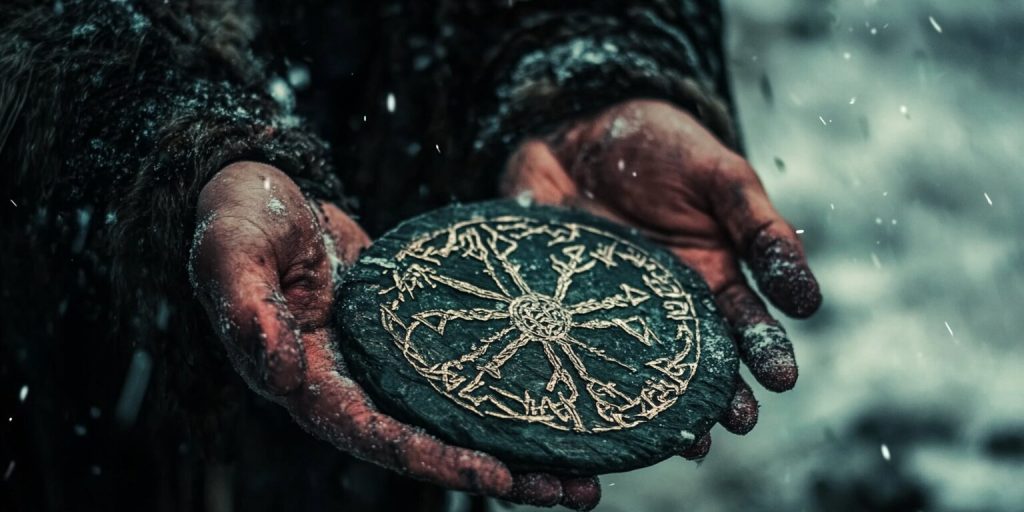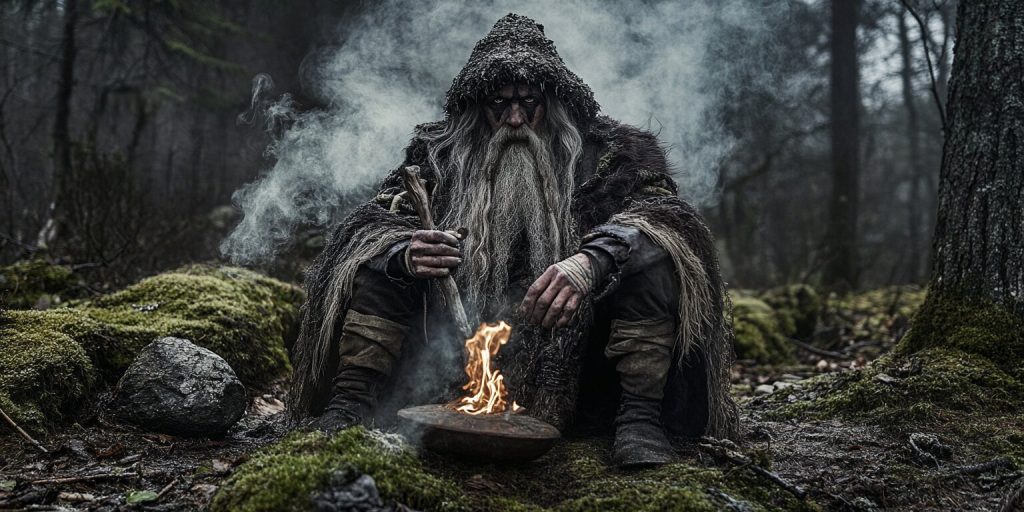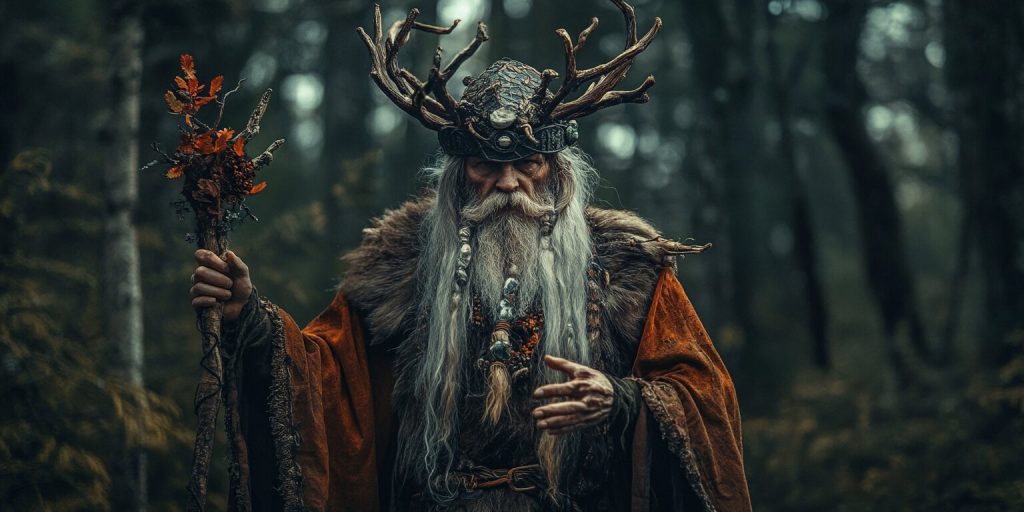Aesir Gods, Norse Mythology, Odin, Viking Heritage, Vikings
What is a Norse Shaman Called?
Norse shamans were key in ancient Scandinavian culture. They were known as “Völva,” which shows their important role. They were healers and diviners who connected the human and spiritual worlds.
Their legacy lives on in sagas and Eddic poetry. These stories celebrate their mystical powers and the significance of seiðr. They were deeply connected to nature and the cosmos.
Understanding Norse Shamanism
Norse shamanism is a deep part of ancient spiritual practices in Viking culture. It connects closely with animistic beliefs in Northern Europe, creating a world where people and spirits live together.
Exploring this relationship reveals the rituals and beliefs of early Norse people and their connection to Yggdrasil, helping us understand their spiritual lives.
The Roots of Norse Spiritual Practices
Norse shamanism is built on a web of traditions and ancient practices. It teaches us about the connection between all beings and nature. Early Norse societies saw their world as full of myth and magic.
They believed every tree, river, and mountain had a spirit, which led to a deep respect for nature. This belief also guided their healing rituals and divination.
Key Concepts in Norse Shamanism
Key concepts are at the heart of Norse shamanism. One is journeying, where shamans travel to spiritual realms to talk to spirits, such as ancestors and animal guides.
Rituals often include healing and seeking guidance. Shamans used these rituals to connect people with the divine. This role is shown in Norse mythology.
Norse Shaman Titles: Who Were They?
Norse shamanism had many titles for its practitioners. The völva was a woman known for prophecy, healing, and rituals. Knowing about these Norse shaman names helps us better understand Viking culture.
The Role of a Völva
The völva was very important in Norse society and practiced shamanism in Norse. She was seen as a seer and healer. Her work went beyond just telling the future.
She led rituals and gave advice based on her visions, often inspired by the Poetic Edda. Her connection to the spiritual world was key. It helped her link the divine with humans, making her a vital shamanic figure in Viking spirituality.
Different Names for Norse Shamans
There were many titles for Norse shamans, reflecting their roles in shamanic rituals. “Seiðmaðr” was for male practitioners of seidr, a key ritual. Female practitioners were called “seiðkona.”
These names show the variety of Viking healer names and the importance of shamanic practices in their culture.
The Nordic Shamans and Their Practices
Norse spiritual practices were full of traditions. They included seidr and shamanic healing. These were key to Viking culture, meeting both spiritual and community needs.
Nordic shamans connected humans with nature and fate. They used many techniques to do this.
Seidr: The Ancient Norse Magical Practice
Seidr was a deep part of Norse shamanism in Scandinavia. It involved going into a trance to explore other worlds and talk to spirits. Practitioners, led by a völva, a Viking shaman woman, used chants and rituals for their journeys into the spirit world.

This magic helped them understand the fate and the causes of sickness. Seidr made them wise healers and spiritual leaders, integral to the Vikings’ shamanic traditions.
Healing Practices in Viking Culture
In Viking culture, healing was more than just herbs. Shamans were key to their communities’ health. They mixed natural medicine with spirituality.
They did rituals with herbs, prayers, and magic words. This helped fix physical, emotional, and spiritual problems. Shamans worked with nature to heal, using ancient wisdom and seidr.
Connection to Norse Mythology
Norse shamanism is deeply connected to Norse mythology, and Odin is a key figure. He is linked to knowledge, magic, and shamanic practices, and his story shows the value of wisdom gained from shamanic journeys.
Odin and the Shamanic Tradition
Odin’s role in Norse shamanism is deep. He is seen as a wanderer seeking life and death’s secrets, and his shamanic journeys give him special powers.
Odin discovered shamanism’s power through sacrifices and rituals, which became a big part of his identity.
Shamanic Journeying in Norse Lore
Shamanic journeying is key in Norse traditions. Shamans used special states to explore spiritual realms and seek guidance and understanding.
This journey was a way for shamans to connect with the divine. They would enter trance-like states and talk to mythical beings for wisdom and healing.
Mythical Beings Associated with Shamans
Odin is not alone in Norse shamanism. The Vanir gods and goddesses, considered deities, are also important. They are linked to fertility and nature, reflecting the beliefs of the ancient Norse people.
These beings help shamans during spiritual journeys, offering guidance and help. This shows the deep connection between mythical beings and shamanic traditions.
Rituals and Tools of a Norse Shaman
Norse shamans did many rituals to connect with spirits and help their communities. These rituals were full of meaning and tradition. They helped people talk to gods, find answers, and heal.
Common Rituals and Their Purposes
Some key rituals included:
- Healing Rites: Shamans performed ceremonies to heal body and soul, aiming to restore balance and health.
- Divination Rituals: Shamans used tools to get insights into the future or solve problems. They used their tools to help.
- Honoring the Gods: Rituals to honor gods were important for protection and favor. They included offerings and prayers.
- Community Gatherings: Some rituals brought people together. They helped build unity and shared identity.
Shamanic Tools: Runes and More
Norse shamans used many tools, but runes were vital. Runes helped with communication, divination, and protection. Skilled shamans carved runes into materials for their power.

Other tools included:
- Drums: Drums helped shamans enter trance states, a common practice in ancient cultures. They journeyed to other realms in the spirit world for wisdom.
- Staffs and Wands: These tools channeled energy. They showed the shaman’s power.
- Herbs and Natural Elements: Plants and materials were used for healing and spiritual connection. Each had special meanings in the context of old Norse religion.
Norse shamans, as shamanic figures, used rituals and tools to connect the physical and spiritual worlds. They guided their communities in healing and growth.
Modern Perspectives on Norse Shamanism
Today, people are more interested in Norse shamanism than ever before. They want to connect with their ancestors and find a holistic way to heal. This interest shows how spirituality has changed over time.
Revival of Ancient Practices Today
Many now use old shamanic ways from the Viking Age, including seiðr. They do things like:
- Rune casting, which helps make decisions, is a practice from Norse shamanic traditions.
- Shamanic journeying for self-discovery and spiritual growth is rooted in the old Norse religion.
- Holistic healing is for body, mind, and spirit health.
Today, we see how valuable these old methods are. They help us grow and learn.
Integration in Contemporary Spirituality
People are mixing old rituals with new ideas, which makes modern Norse shamanism special. It uniquely combines different spiritual traditions.
This mixing creates a rich space for exploring spirituality. As more people join shamanic studies, our understanding of shamanism grows. It shows a desire for real connection in our fast-changing world.
Bottom Line
Norse shamans have a deep understanding of the spiritual world. They have shaped both ancient and modern spiritual landscapes. Their practices, rooted in tradition, offer healing and guidance.
They also help us connect with nature and the cosmos. The rituals and tools they use are tied to Norse mythology. This shows how important Norse shamanism is for understanding us.
The impact of Norse shamans, particularly through seiðr, is still felt today. People are interested in these ancient practices again. This interest helps us reconnect with the earth and life’s cycles.
Norse shamanism offers valuable wisdom. It reminds us of our spiritual connections to each other and the divine. This is a powerful message for today.
The value of Norse shamanism goes beyond history. It helps us understand our place in the world. It shows how everything is connected in the context of Nordic shamanic beliefs.
Recognizing Norse shamans’ contributions enriches our history and finds new spiritual growth and personal development paths.

